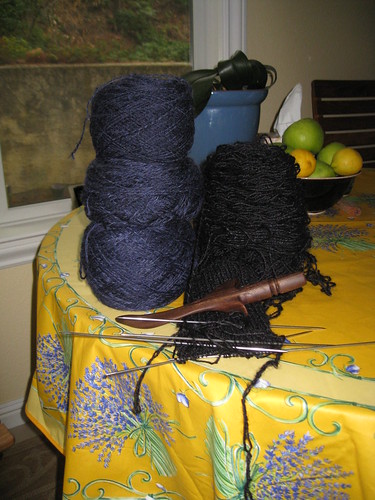I just passed a milestone and had something of an epiphany.
I am working with Cotswold, spinning and swatching for a gansey. I had been working toward finer singles, but had stalled at about 35 WPI due to lack of skill to spin the coarse wools finer.
However, when I did finally get to 40 WPI, I realized that gave me 10 hanks per pound, and 1,000 yards of 5-ply per pound. This all harkens back to a standard for cottage hand spinning on an industrial scale.
Coarse long wools such as Cotswold were an important industrial fiber. With hand spinners in different communities, using different equipment under different conditions, some kind of commercial standard for spinning coarse wools was necessary so weavers and knitters would know what to expect. When all spinning was still by hand, 40 WPI was about as fine as such a diverse group of spinners could consistently produce. It was an easy standard to enforce by giving each spinner a length of dowel with 2 marks on it and telling them the single must wrap so many times between the marks.
Certainly, any good spinner could spin that wool finer, but the standard was a commercial compromise between human variability, technology, and economics.
Then, 2-ply yarn was about 2,500 yarns per pound, 4-ply was about 1,250 yd/lb, and 5- ply was about 1,000 yards after tight plying – all a direct consequence of wrapping a single around a piece of dowel with two marks on it. Do those numbers ring a bell? They have the virtue of being easy math in a cottage industry where many can’t read / write, but can do commercial arithmetic, and make their mark.
After about 1770, factory spinning in England was so much cheaper and better than cottage spun yarns that industrial and domestic users both switched to factory spun yarns. The market for handspun yarn crashed, and hand spinning was no longer a viable commercial activity - except for a few niche markets.
The traditions of the cottage industry of spinning industrial yarns was lost. People bought their 5-ply. After families had bought their 5-ply for 4 generations (60 years) families assumed that they had always bought their 5-ply.
The factories produced yarns similar to those that had been previously produce by the cottage industry. They did not have mass media to teach weavers and knitters to use new kinds of yarn, so the spun yarns that were similar to the yarns that had been produced in cottages and homes for hundreds of years. In 1800, knitters and weavers bought yarns of the same thickness that they had bought 50 years earlier because those thicknesses of yarn produced textiles suited to the environment. A hundred years later in 1900, central heating and better windows was resulting in a warmer living environment for many. Thus, by 1920, very different kinds of textiles and yarns were required for the new living environments.
However, in 1820, clothing requirements were very similar to what they had been in 1720. Fashion changed, but the amount of insulation that the clothes were required to provide did not change much. Thus, the nature and types of yarn produced changed more between 1820 and 1920 than it did between 1720 and 1820 despite the fact that in the later period yarn production moved from hand spinning in cottages to the factory.

.jpg)